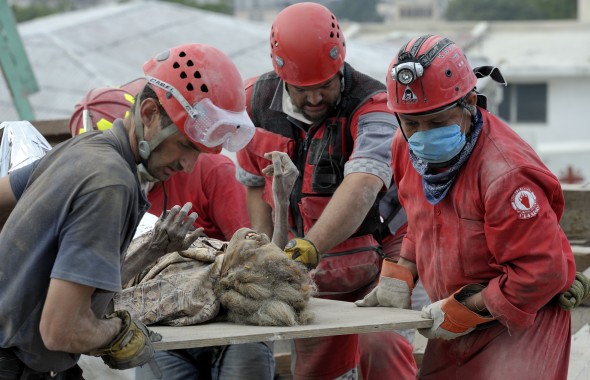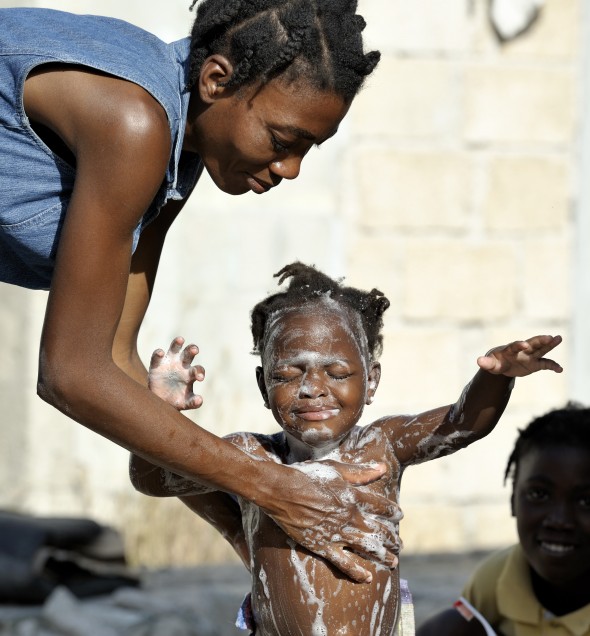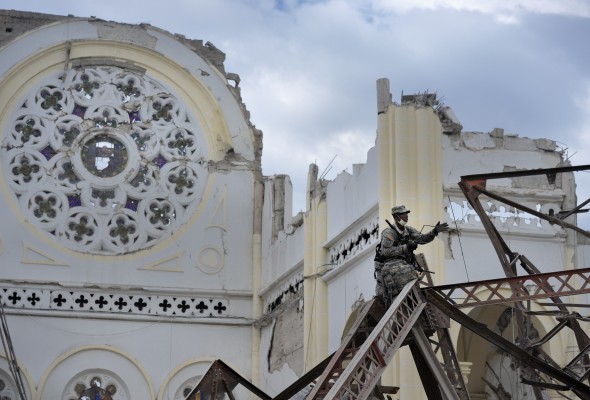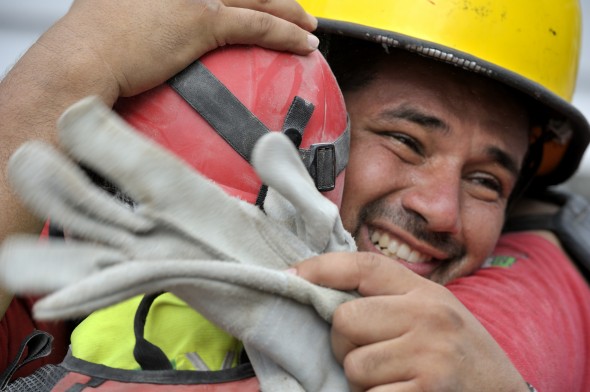Global Lens Reflections on life, the universe, and everything
Haiti: witnessing hope amidst the ruins
Ena Zizi was rescued by the Gophers today. As her dirty and injured body–resting on a broken piece of plywood salvaged from the rubble–was carefully passed down over three stories of debris to the ground, the 70-year old woman began singing, a not very articulate song as she hadn’t had any water to drink for seven days. Yet her joy was infectious. Members of the Mexican rescue team carrying her began crying. In the shadow of the Roman Catholic cathedral in one small corner of Port-au-Prince’s tortured and grieving landscape, other rescue teams stopped their digging for a moment and applauded. Amidst so much suffering, it was an extremely precious moment of joy.
I had the privilege to be present because I’ve come to Haiti to document the earthquake response of the ACT Alliance, an international network of churches and church agencies responding to emergencies. It took me a while to get here. People at the ACT Alliance’s headquarters in Geneva contacted me within hours of the quake, but I couldn’t leave until after a memorial service for my mother, who died in December. Within hours of her service, I was on a plane to New York, then a flight to Santo Domingo, then the eight-hour overland trip to Port-au-Prince, arriving the evening of the 18th. Because there’s a shortage of safe places to stay, I’ve pitched a small tent on the roof of the Petionville office of the Lutheran World Federation, one of several ACT members which has been active in Haiti for years. If there’s another Big One, at least the building won’t fall on top of me. Sitting up here with my friend Don Tatlock of Church World Service, who has a tent pitched just beside me, we joke about how we’ll surf the collapsing roof as the building slides down the hill. It passes for humor here.
Because the ACT members’ capabilities to respond are already overtaxed–having your offices collapse, your vehicles crushed, and most of your staff living in the streets will do that–I made arrangements for my own translator and driver. After days of calling from the U.S, I was fortunately finally able to get in touch yesterday with Ulrick, a young man who translated for me in November when I was last here. He lost his mother in the quake, but he and his small son are thankfully ok. They’re living in a park, under a sheet strung between polls. They call it a tent.
Ulrick found a cousin with a tap-tap, a colorfully painted pickup truck that’s used as a taxi in Haiti, and negotiated with me an appropriately exaggerated amount for their services. It’s a seller’s market: there’s no fuel available, most of the roads are blocked, many vehicles are destroyed, and the town is filling up with people who need those things. So this morning they picked me up and I set to document the quake’s aftermath and how people were responding.
Although the devastation is pretty overwhelming, I’m not interested in merely replicating the disaster porn that has passed as coverage in many media to date. Yes, it’s terrible, yes, a lot of people died, but is that all? There’s another story I’d like to document, and that’s how ordinary Haitians are showing incredible determination to survive and help each other. Images like this one of Silvani Joseph, who today I found working with some other survivors in Port-au-Prince’s Belair neighborhood digging out a building, salvaging usable cement blocks, stacking them for use in rebuilding whatever it is they’ll someday rebuild.
Or this woman washing her daughter in the ruins. A small moment, but a glimpse of everyday compassion made special because it stands against a background of horror.
Although it’s a week after the quake, there are still a few people being miraculously pulled out of the ruins alive. I was blessed with the opportunity to be there for the rescue of Ena Zizi and be able to capture the photos I did. I owe that fortune, in part, to CNN’s Anderson Cooper. You see, I was checking out the city’s Roman Catholic cathedral, whose ruins I thought could make strong images. There was a contingent there from the U.S. Army’s 82nd Airborne Division, and they were very restrictive about access to the areas around the cathedral.
I shot some photos of the soldiers checking out the ruins, but when I heard from some bystanders that there was perhaps someone being rescued alive from a house to one side of the cathedral, some soldiers blocked my way. Arguing with them got me nowhere. In fact, it got me yelled at by some superior officer when I insisted on speaking to someone in charge. Oh well. We walked back toward the tap-tap and at that moment I saw CNN’s Anderson Cooper pull up. His small contingent included some sort of military guy, and when they started walking around the corner of the cathedral towards where we’d been turned back, I yelled at Ulrick and Sarah, a British journalist who was with us, that we should follow. We went jogging around the ruins to arrive at the military perimeter just as the CNN crew did. They were waved through the checkpoint by soldiers holding up the rope that had blocked access. We followed close by, and I noticed Ulrick grinning victoriously at one of the soldiers. We followed in CNN’s footsteps until we got to a small doorway between two collapsed buildings. Anderson stopped to check that all his crew was coming, and he noticed us tagging along. He stepped into the middle of the doorway and looked at me with a look that said, “Who are you?” So I reached out and shook his hand, told him who I was, and said we’d been denied access but really appreciated his help in getting us through. I then walked around him through the doorway. Sarah and Ulrick followed. We quickly learned that the Mexican crew was trying to extricate Ena Zizi, and so I climbed a three-story high pile of rubble (not always easy–one of Ulrick’s jobs was pushing me in the butt to keep me from sliding back down the slabs of dust-covered building stones). About five minutes later, the Mexicans pulled her out. The moment was captured by a Reuters photographer, the CNN crew, and me. Thanks for your help, Anderson.
The tears were contagious. As were the cries of “Viva Mexico!”, even from rescuers of other nationalities. A Mexican hugged one of his colleagues and said, in typical Mexican slang, “Gracias por traerme aqui, cabron!”
The Mexicans who saved Zizi’s life are known in their home country as the “Topos of Tlatelolco”–the Gophers of Tlatelolco, a giant apartment complex in Mexico City that was destroyed by the 1985 earthquake. When the government failed to respond promptly, Tlatelolco residents formed their own rescue brigade, learning on the job. Over the years since, they have become stars among international rescue teams. Unlike some rescuers, who stay on the surface and peel away the debris until they reach the victims, the Gophers have become world renowned experts at tunneling into rubble, propping up makeshift tunnels with debris, gaining faster access to survivors. It means they put their own lives more at risk, but that risk paid off for Ena Zizi.
It’s near midnight and I’m now back at the Lutheran World Federation office finishing the processing and transmission of some of those images. We don’t have much water to wash with, and the electricity comes from a very loud generator, but the satellite internet link is thankfully strong. I may smell bad, but I can connect. Gracias por traerme aqui.





